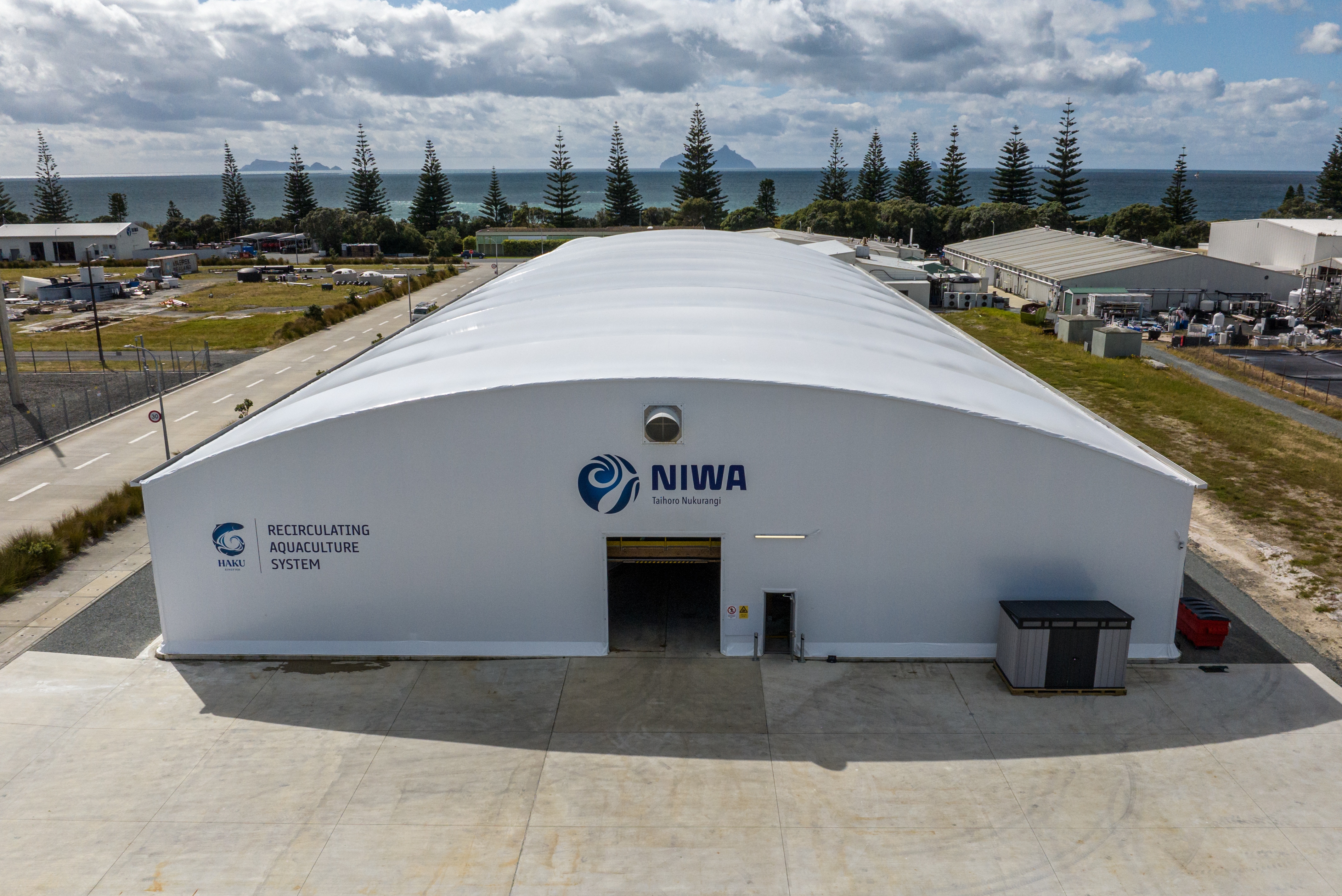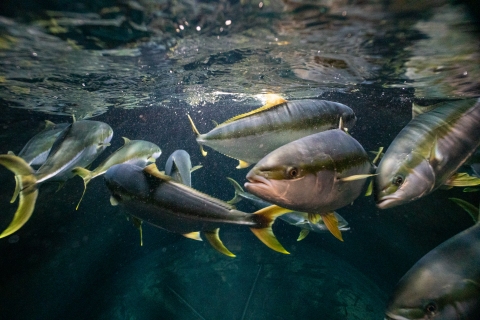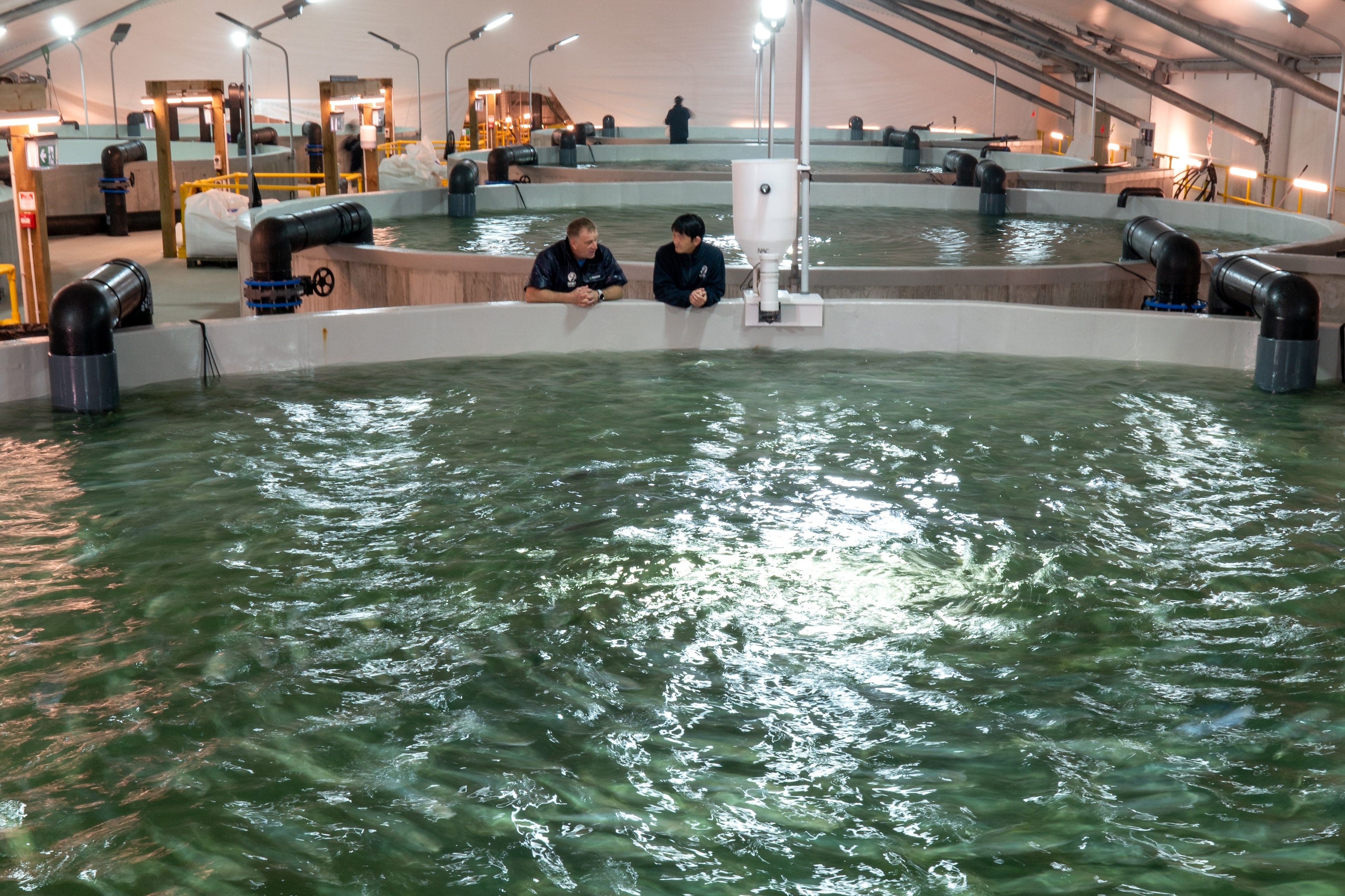We have the NZ’s largest RAS facility in the commercial-scale yellowtail kingfish RAS farm on site (Northland Aquaculture Solution), housing eight 350,000 litre grow-out tanks.
The commercial RAS facility
Overview
In 2002, we started researching how we could produce large numbers of kingfish so everyone could enjoy them. What we learned was that a land-based system is best at producing superior fish that could be grown sustainably and supplied all year round.
Our Northland site contains the largest RAS research facility in the Southern Hemisphere and Asia Pacific. NIWA’s understanding of the market, combined with the biological, technical and financial feasibility of growing these fish, means up to 600 tonnes of Haku kingfish can be harvested from the facility each year.
Advantages of using RAS
Recirculating aquaculture systems (RAS) are a land-based production technology for aquatic organisms and high-value finfish. They utilise water treatment technologies (mechanical and biological filtrations) to minimise water use and maintain a tightly controlled environment. These can range from very open systems that use only basic treatment technologies to reuse some of their water resource, to fully closed systems which reuse 100% of the water and only add new water to account for splashing and evaporation. RAS vary in their design and functionality depending on the species being produced, the local conditions and the cost/access to a local water resource
- Reduced water requirements. Water is treated and recirculated, significantly reducing water requirements.
- Production Control. Water can be heated/cooled, high oxygen can be maintained, pH adjusted, pathogens treated, and waste products removed to maximise health, growth rates, and the welfare of the stock.
- Increase in long-term production. Stock are unaffected by seasonality, periodic disease events and adverse weather, allowing continuous and reliable production.
- Reduced environmental footprint. Waste streams are treated and recycled to ensure they have the least impact on the environment as possible. Being land-based, there is also no risk of fish escaping and interbreeding with wild populations.
- Flexible design. The system can easily be customised for different species, locations and consumer preferences.
Animal welfare
As a Crown Research Institute, NIWA is a role model for animal welfare in the industry and has a strict code of Animal Ethics for the research and development of aquaculture species. We conduct specific research on fish health and welfare, such as disease treatment, stress physiology and water conditions, to ensure the best growing conditions at our facilities. Production processes further support the welfare of our kingfish.
Our water quality is continuously monitored, we maintain optimum stocking densities and our fish are fed a wholesome, nutritionally complete feed. We are committed to using feed from certified sources that have a continued interest in sustainability and research on more efficient specialised diets. Currently, our main supplier of feed is BioMar in Tasmania.
Haku kingfish
Learn more about the fish that chefs and patrons are talking about here



Other RAS units
Overview
The Northland Aquaculture Centre has two RAS designed for experimental programs that test the effects of RAS conditions on fish performance, or the effects of biological inputs on RAS performance. The treatment components of the RAS are designed to be flexible so that new technologies, and different combinations of technologies can be tested (biofilters, drum filters, degassers, foam fractionators etc.). Both RAS are designed to allow for the simultaneous measurement of fish performance, whole-system performance, individual component performance and water quality parameters while maintaining precise temperature control water quality parameters.
Beyond applied research, these systems are ideal for testing or ground-truthing of products (e.g., commercial diet, novel RAS component, breeding values) or methods (e.g., novel rearing protocol).
RAS unit 1
6 x 5m3 tanks with direct oxygen injection, automated feeders and feed recovery for each tank. The system is capable of being setup in a multitude of different configurations. Filtration components can be plugged in at any stage, making the comparison of different known technologies to be easily undertaken alongside the new innovations being developed at the NMRC. Energy inputs and waste outputs can be quantified at different locations allowing differences in efficiencies and performance to be measured in real time. Temperature, photoperiod, pH, O2 saturation, water flow rate, feed rates, meal times and stocking density are a few of the various parameters that can be manipulated and tested side by side.
- 6 × 5000 Litre tanks capable of rearing a variety of finfish species, at different sizes and at high stocking densities.
- Tanks can be stocked up to 100kg/m³ = 500kg/tank= 3000kg for the unit
- Connecting RAS systems capable of being split into 2 identical units
- Ability to run both freshwater and seawater.
- Capability to run tanks at various turnover rates up to 20min refresh
- Capability to run at various system refresh rates
- Flexibility to run various trials, using different water treatment methods and system/tank/water flow configurations
RAS unit 2
3 × side by side systems consisting of 2 × 25m³ tanks per system. Many of the same capabilities are built into the second unit but with 3 larger scale replicate systems. Many of the lessons learn in the smaller RAS have been built into this unit as a standard. The lager tanks give a more commercial like environment, allowing trials to be more focused on the anticipated challenges that will come with full commercial production. The 3 replicate systems ensures that multiple variations in systems setup and husbandry techniques can be explored and measured. Energy efficiency, waste capture, and production cost reduction can be explored on a larger and therefore more realistic scale. Economic gains from technological innovation at the NMRC can be demonstrated, quantified and tested against other more traditional rearing practices. Improvements in waste capture and environmental impact can also be tested and shown in real life.
- 6 × 2500L tanks capable of rearing a variety of finfish species, at different sizes and at high stocking densities.
- 3 × connecting RAS systems capable of supplying 2 tanks per system.
- Tanks can be stocked up to 100kg/m³ = 2500kg/tank = 15000kg for the unit
- Ability to run both freshwater and seawater.
- Capability to run tanks at various turnover rates up to a 15min refresh
- Capability to run at various system refresh rates
- Flexibility to run various trials, using different water treatment methods and system/tank/water flow configurations
